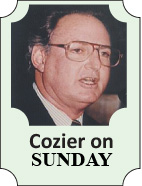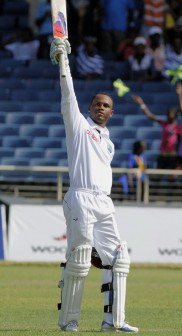With West Indian attention firmly set on London and our special stars at the Olympics on track and in pool, a breathtaking individual performance in the team discipline that first established the region’s sporting excellence passed on Friday at a hallowed Caribbean cricket venue without the acclaim it truly deserved.
For nearly four-and-a-quarter hours, on a hot, steamy afternoon at Sabina Park in his native Kingston, Marlon Samuels fashioned an innings as close to perfection as is possible against New Zealand’s combination of disciplined, aggressive and purposeful seam and swing bowling on an encouraging pitch.
Without him, the West Indies would have been reduced to utter humiliation as their effort to add to their convincing first Test victory became unstuck.

His 123 was 58.85 per cent of the unsatisfactory total of 209 that conceded a first innings lead of 51. Only four batsmen (Greenidge, Nurse, Gomes and Lara) had previously so dominated a West Indies score sheet.
Nor was it against the attack that was so ineffectual on a flat pitch in the first Test that it conceded totals of 522 and 102 for one.
It was apparently weakened by the absence of its two best credentialed and experienced bowlers, New Zealand’s most capped player, left-arm spinner Daniel Vettori (370 wickets, 112 Tests), sidelined by injury, and fast bowler Chris Martin (229 wickets, 69 Tests), sidelined by bold selectors. In fact, it was strengthened.
The responsibility to compensate for another batting failure on the opening day rested with four eager young quicks, Trent Boult and Neil Wagner, both left-arm, Doug Bracewell and Tim Southee, right-arm. Wagner, in his second Test, was the eldest at 26; collectively, there were just 29 Tests among them.
They were not to be underestimated on the basis of these statistics. With the exception of Martin for Wagner, these were the same bowlers who dispatched Australia for 136 and 233 at Hobart last December, albeit in more helpful conditions, to achieve a rare and celebrated triumph on their large neighbours’ territory.
A measure of their control over everyone but Samuels was glaring.

Chris Gayle, Jamaican as well and the modern game’s feared dominator, who had set out on his 150 in the first Test with four fours in the first over, was confined to eight from 55 balls without a boundary. He had already snicked a missed chance to first slip before Wagner throttled him with a vicious lifter that he fended off to point.
Shivnarine Chanderpaul, usually the most immovable object in Test cricket, scraped nine from 40 balls before he was one of six batsmen caught in the slips off tentative outside edges.
The others were simply not good enough to withstand the well drilled New Zealanders who rarely veered off the required line and length .
The contrast with Samuels was simply stunning. When he was not on strike, a wicket never seemed far off. For the 169 balls that he was, there was hardly a delivery that genuinely defeated him, hardly a false shot.
There were peerless drives in all directions, most through the covers and down the ground. With five pair of hands waiting for another offering in the ring between `keeper to point, his penchant for open-faced steers to third man appeared fraught with danger. But, as with the occasional sharp bounce, they were expertly crafted by soft hands that kept the ball well short of the waiting predators.
There was an awesome climax to his awesome innings. He was 78 when captain Darren Sammy was seventh out after a typically robust 32. Accurately assessing that if the top order was found wanting, so would the tailend, he immediately switched from measured elegance to calculated violence.
With Tino Best his last partner, he raised his fourth Test hundred with a flat six over extra-cover off Southee and then hoisted the next two balls over the ropes. A single carried him to meet Doug Braceweill at the opposite end and he creamed him for a straight six as well before he was expertly caught by the leaping Wagner inside the boundary at deep point going for another.
Of the 47 runs yielded by the last three wickets, all but Sunil Narine’s single had come from his bat.
All told, it was a feat that presented further confirmation that a player so long justifiably regarded as a wastrel had finally found his groove.
For 10 years after his Test debut as a richly talented 19-year-old in the cauldron of the Melbourne Cricket Ground, Samuels so exasperated selectors with an average below 30 and just two hundreds in 29 Tests that they only spasmodically included him in their teams
When given a two year suspension by the International Cricket Council (ICC) in 2009 for his naïve association with an alleged Indian bookmaker, he was going on 29. His career seemed at an end to all but Samuels himself.
To him, it was a sharp wakeup call. He set his mind to returning to the West Indies team and did so by putting figures in the computer for Jamaica in the regional season the selectors could not ignore.
Since then, he has gone from strength to strength, never stronger than this year in three Tests against England’s strong bowling in May and June and now against New Zealand. He averaged 96.5 in the former, with scores of 31 and 86, 117 and 76 not out and 76, all fashioned with eye-catching style; back home, he quickly stroked an unbeaten, Man of the Match 101 in an ODI at the same Sabina Park that witnessed his best in the Test.
So how come the transformation?
“I’ve been through some tough times but I’m here still playing cricket,” he said on Friday.
“It’s my time to enjoy my cricket. Waking up in the morning, I don’t worry about getting a game. I know I’m going to get a game. I worry about how I’m going to start my innings. It’s a different mindset. I am definitely at peace with myself.”
As with all things, it’s better late than never.





